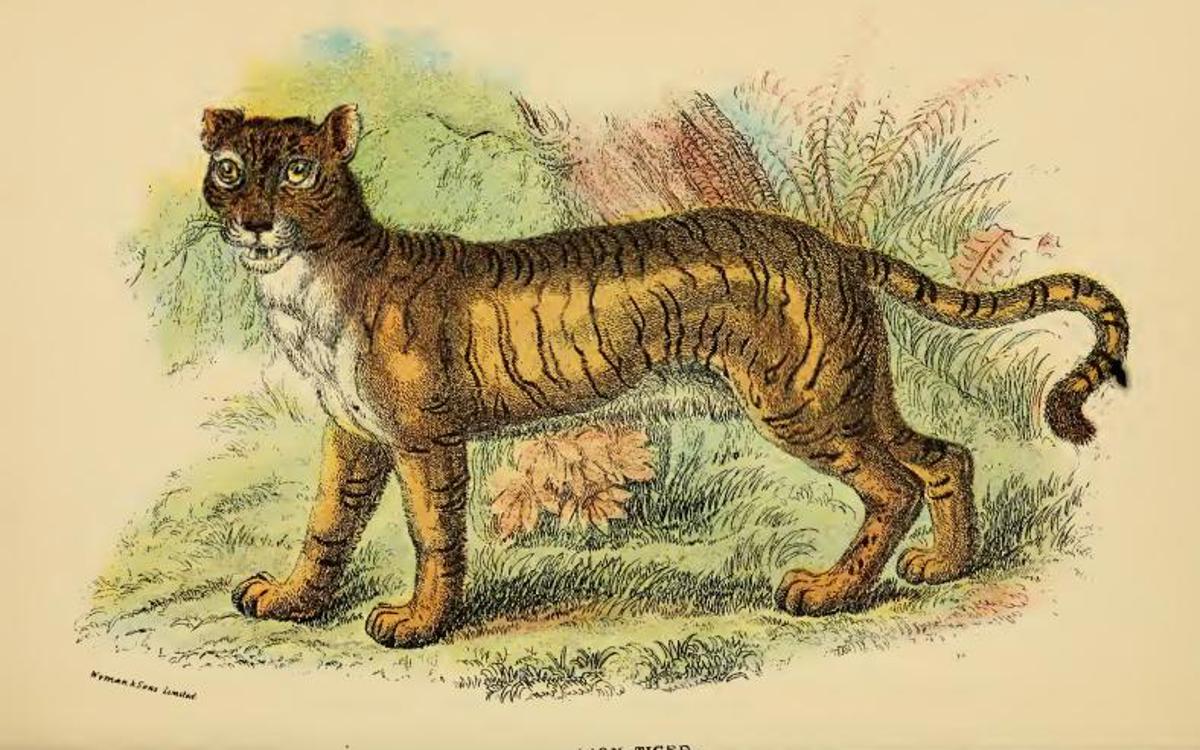How romanticised ideals of the natural world overlook deep historical relationships with nature.
By Kartik Shanker, Indian Institute of Science

How romanticised ideals of the natural world overlook and undermine deep historical relationships with nature based on various forms of use.
By Kartik Shanker, Indian Institute of Science and Dakshin Foundation
Snake charmers, elephants with headlights, yoga, vegetarianism, transcendental meditation – India is many things to its audience, much of it false or at least misleading. But perhaps one of the most specious of these is the idea that it is the ‘land of tigers’.
A famous (and obviously white) biologist has been quoted as saying: ‘It is difficult to visualize India without tigers. It will be like imagining an inky black sky without stars’. But in whose imagination? Most people in India have never seen a tiger. And those who do encounter them as part of their daily lives often do not want to.
More or less since independence, it was in fact the lion that was associated with India, as the government had adopted Ashoka’s Lion Capital – a sculpture with four Asiatic lions back to back – as its national emblem. Tigers became the national animal of India only in 1973, ostensibly because they were found across the country in a wider range of landscapes and were more ‘representative’ of the country’s wildlife. One conservationist became so obsessed with tigers that he wrote an entire book on how lions are not native to this region. That there is little support for that argument is beside the point.
Foisting imagination upon reality, either by foreigners or a homegrown elite, is neither new nor native to India. The birth of conservation is itself rooted in false notions of nature. But how did these illusions come about?
The myth of virgin nature
In north America, Henry David Thoreau’s portrayal of nature in Walden and his writings on ecology and environment led to the development of an idea of pristine wilderness. John Muir, the ‘father of national parks’ took these ideas into the state domain and campaigned for the establishment of national parks that would be free of human presence and influence. On a camping trip with President Theodore Roosevelt deep in the heart of Yosemite, the latter referred to a sequoia forest as a ‘temple built by no hand of man, a temple grander than any human architect could by any possibility build’. No wonder then that this movement to create pristine natural areas should become nothing short of a religion by the 20th century – one that might be called ‘pristianity’.
But landscapes such as Yosemite and Yellowstone were not in fact pristine. They were myths created in the 18th and 19th century by adventurers, naturalists and, later, that PR wing of pristianity: nature photographers. These landscapes had been peopled and modified by Native Americans for thousands of years. What the colonisers saw and admired were actually areas that had been used, burned, grazed, and occupied. But they saw them at a time when their own actions had extirpated or displaced those human populations.

How deeply ironic then that the very idea of a conservation landscape derives from this false notion of virginity, created by the descendants of those responsible for the illusion. And how strange that a century later, we would continue to define conservation in this way across the world, as outsiders.
The sanctity of species
Another striking example of the tinted conservation lens can be seen in our Brahminical notions of what species are. When I was a child, we lived in Kolkata (then Calcutta) and visited the Alipore Zoo frequently. In addition to its various attractions were tigons and ligers – products of hybridisation between lions and tigers. There was even a litigon - the offspring of a lion and tigon - the name of which sounds suspiciously like there were grounds for a legal case. That these chimera were then considered to be interesting experiments (or accidents) and a public spectacle is in stark contrast to the pointless mutants that most wildlife conservationists consider them now.
In fact, conservationists have in general developed an utter distaste for hybrids of any sort, even within species, as though these are ‘immoral’ acts. But they occur in nature far more frequently than once believed. In fact, some evolutionary biologists have made a strong case for the role of horizontal transfer (gene flow between species rather than within) in driving evolutionary processes. Yet 20th century ideas of species as sacrosanct units remain and drive much of global conservation planning.
Sea turtles, a group I have worked on for nearly 30 years, break all kinds of rules. Apart from traversing ocean basins to get from feeding to breeding grounds with little regard for national and political boundaries, they also show little respect for species boundaries. In many regions, but particularly off the coast of Brazil, loggerhead turtles pair with both olive ridley and hawksbill turtles, producing fertile offspring that then continue to interbreed with parent populations. This flies in the face of conventional wisdom that hybrids cannot be fertile – something that tigon in Alipore Zoo was evidently unaware of too.
More striking in the case of sea turtles is that the loggerhead and hawksbill, for instance, are not even closely related species; they diverged 30 million years ago. That is similar to the divergence between humans and monkeys like macaques and langurs; in fact, humans and chimpanzees diverged just 12 million years ago. Recently, evolutionary ecologists have started to ask what role these transgressions might play in the evolution of these populations.
Surely then, some ideas of the sanctity of species are not based on science, but perhaps on our notions of purity. So strong are these that conservationists are loathe to breed the highly inbred and vulnerable Asiatic lion with the far more genetically diverse African lion, which could produce healthy hybrids and create greater resilience in the population to disease and other factors. Again, how far our notions of nature are from the fuzziness of reality!

Dinner or demigod?
The fundamentalist approach of conservation is perhaps best reflected in our confused ideas about our utilitarian relationship with nature. Like many others, I have often used the phrase ‘I love fish’. This could justifiably be interpreted as one or more or even all of the following:
- they taste good
- they have amazing diversity
- they are beautiful to watch
- they are required to support coral reefs or ocean ecosystems
- they sustain coastal populations
- they have medically important compounds
- they are great research models
- they make great fridge magnets
Taken across humanity, each one is indeed true for one person or another.
On the other hand, I have also often used the phrase ‘I love turtles’. Almost never is this interpreted to mean anything other than that I love watching them or that I conduct research on them or that I want to protect them for their own sake. Never would it be interpreted in ‘civilised’ society as meaning that I love turtle meat.
Why then this dichotomy? How did some species get designated as demigods in this pantheon of pristianity? Again, this would appear to derive from a singular or fundamentalist view of nature. Many ideologies about conservation (or preservation, to be more precise) are driven by biocentric and ecocentric views of nature that argue that wildlife has an inherent right to exist. This takes many forms such as animal rights, interspecies justice, and compassionate conservation – a movement which opposes the killing of any individual animal.
But these rights often only extend to certain animals – typically birds and mammals, and sometimes extending to all vertebrates – depending on whom you are talking to. Among conservationists, it is not unusual to find rights conferred upon the animal that one ‘loves’, such as dogs, dolphins or elephants. The inherent irrationality is not dissimilar to the simultaneous existence of many monotheistic religions.

Conservation colonised
In Africa, western conservationists have driven the narrative of conservation for nearly a century. Kenya’s national parks were established by a British conservationist, and similar stories abound across the continent. What is galling is that, in addition to past atrocities, animal rights activists, compassionate conservationists, and others of their ilk continue to try and control conservation in distant and often low-income nations.
Recently, the controversy surrounding trophy hunting has attracted much media attention. While there can be valid critiques with regard to which animals are hunted and whether revenues reach the people who need it, anti-hunting campaigns are often misinformed or intentionally misleading. Moreover, most of the opposition is actually about the killing itself. This is odd for many reasons. Hunting has been closely linked to human evolution, with animal protein regarded as an important driver of the increase in brain size. But the sports hunt may have had a role as well; in fact the hunting of large dangerous animals is believed to have been used to signal dominance of both individuals and societies.
But evolutionary history apart, the right to use nature – through hunting or other means – is both philosophically justifiable as well as practically necessary. After all, biocentrism is itself a construct of human thought, and while those who subscribe to it are entitled to do so, foisting it upon a large diverse world is as colonial as any other form of oppression. And like other hierarchies, this cultural oppression disproportionately affects the vulnerable and marginalised.
At a practical level, practices like trophy hunting can bring significant income to poorer communities across the global south. Traditional fishing and hunting offer sources of nutrition otherwise not accessible to those communities. Most importantly, what version of equity allows those in the west (or in cities) who have already destroyed their environments, and whose lives have enormous ecological footprints, to dictate that others cannot benefit from their resources in a manner that is ecologically sustainable?
These deep, historical relationships with the natural world based on use – where nature can be simultaneously revered and eaten – form the most fundamental basis of sustainability and conservation. And yet, across the globe, these rich cultural practices are being eroded by the misadventure of modern conservation. In addition to the imposition on culture and economic growth, movements that create exclusionary spaces for nature seek to sever connections with nature for the wider world while preserving these privileges for an already dystopian urban elite. This constitutes an egregious failure of the ethics of equity and human rights, as well as a fatal error in the path to a more universal acceptance of environmental conservation.
In the last two decades, there has been some shift in conservation philosophy and practice. The widespread critique of ‘fortress conservation’ – in which protected areas for wildlife were created by forcefully displacing or excluding their existing inhabitants – has resulted in more community-centric approaches to conservation around the world. But spatially and culturally exclusionary approaches such as ‘Half Earth’ and the oddly uncompassionate ‘compassionate conservation’ remain and might be as great a threat to conservation as any other. In the post-COVID world, it is perhaps more important than ever to strive for what the philosopher John Rawls called ‘reasonable pluralism’: a plurality of reasonable, if often irreconcilable, approaches to the natural world.
Kartik Shanker is an evolutionary ecologist and professor at the Centre for Ecological Sciences at the Indian Institute of Science, Bangalore. He is also the co-founder of Dakshin Foundation, a coastal and marine focused NGO, and founding editor of Current Conservation, a magazine bridging conservation and art.
Images (from top: Illustration of a tiger (main image) by Sayan Mukherjee, courtesy of Current Conservation; photograph of Yosemite National Park by edb3_16 at iStock; liger from an 19th century natural history book, via Wikimedia; illustration of a fishing boat by by Athulya Pillai, also courtesy of Current Conservation.
